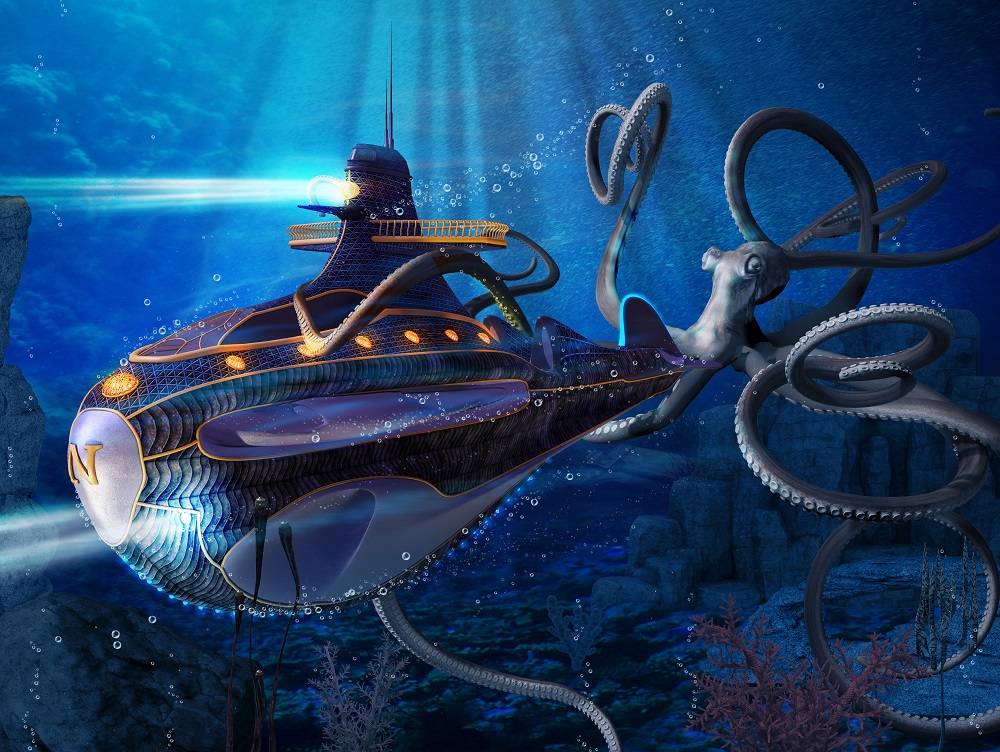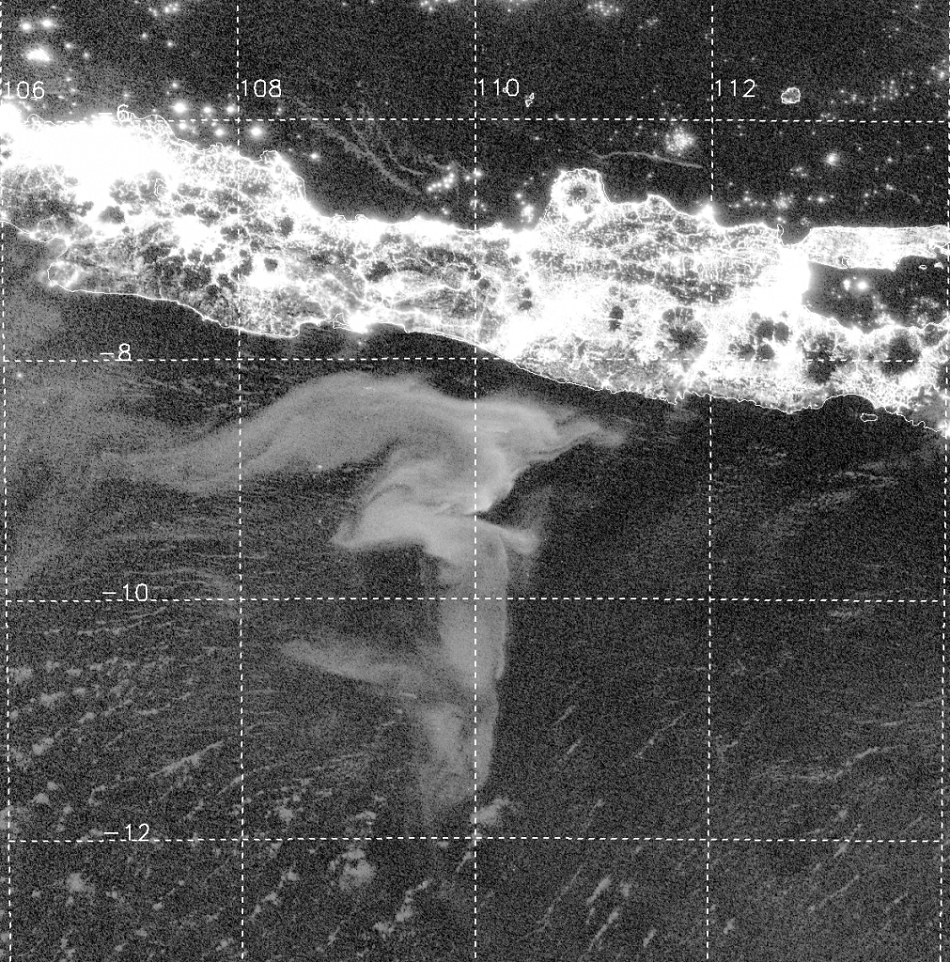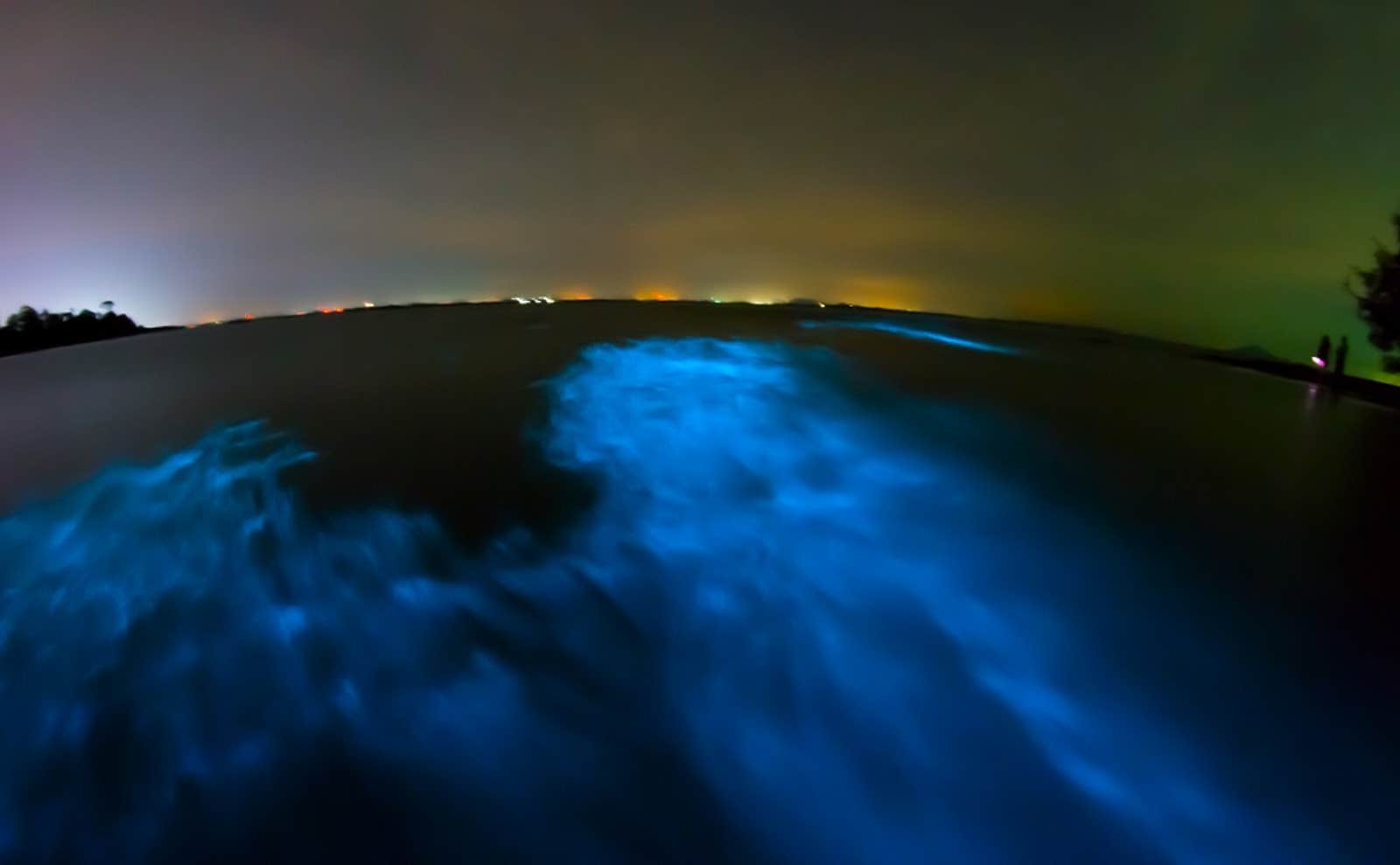On a calm and cloudless night far out to sea, gazing toward the heavens, you’d expect to see the sky glowing with stars, offsetting the impenetrable black of the deep ocean.
But one night 167 years ago, in waters off the coast of Java, Indonesia, things were far from normal. According to an account by Captain W.E. Kingman—best known for describing the Kingman Reef, a remote slip of land in the Pacific Ocean—it was as if sky and sea had traded places. “There was scarce a cloud in the heavens, yet the sky…appeared as black as if a storm was raging,” noted the captain in his logbook. “The whole appearance of the ocean was like a plain covered with snow.” To his apparent horror, the seas looked as if they were glowing:
“The scene was one of awful grandeur, the sea having turned to phosphorus, and the heavens being hung in blackness, and the stars going out, seemed to indicate that all nature was preparing for that last grand conflagration which we are taught to believe is to annihilate this material world.”
While Kingman and his crew did indeed survive this “grand conflagration,” tales of seas that glow have popped up alongside mermaids and dragons in nautical lore throughout the ages. While these creatures of fiction appear in many different guises, the appearance of glowing seas is remarkably consistent.
Jules Verne spins a fantastic tale of these waters in his classic sci-fi adventure novel, Twenty Thousand Leagues Under the Sea. The novel’s protagonist, Pierre Aronnax, describes this otherworldly phenomenon as the fictional Nautilus submarine sails into the Bay of Bengal on the evening of January 27th, 1868:
“As far as the eye could see, the ocean seemed lactified. Was it an effect of the moon’s rays? No, because the new moon was barely two days old and was still lost below the horizon in the sun’s rays. The entire sky, although lit up by stellar radiation, seemed pitch-black in comparison with the whiteness of these waters…. For several hours the Nautilus’s spur sliced through these whitish waves, and I watched it glide noiselessly over this soapy water, as if it were cruising through those foaming eddies that a bay’s currents and countercurrents sometimes leave between each other.”
Tales of seas that glow have popped up alongside mermaids and dragons in nautical lore throughout the ages.
Verne was a diligent researcher and no doubt read historical accounts of glowing seas—such as in Charles Darwin’s HMS Beagle diary, where Darwin noted an encounter with ocean bioluminescence in 1832: “The sea from its extreme luminousness presented a wonderful & most beautiful appearance; every part of the water…glowed with a pale light.” (Whether Darwin sailed through a true milky sea is impossible to know, however.)

Across the Atlantic, Herman Melville contributed to the milky-sea canon in his great American novel, Moby-Dick. An avid reader of whaling literature, Melville also drew upon personal experience as a sailor on whaling ships for Moby-Dick. In one scene, Melville describes a mariner stricken with fear as “his ship [sails] a midnight sea of milky whiteness, as if from encircling headlands shoals of combed white bears were swimming round him…the shrouded phantom of the whitened waters is horrible to him as a real ghost.”
Over a century would pass until a modern-day account could corroborate such tales of milky waters. But in the past decade or so, with an assist from historical record, scientists have discovered that these milky seas, though quite rare, do indeed exist. The challenge is exactly how to find them.
The Hunt for Milky Seas
You’d think it would be easy to find glowing waters the size of a small country, but the ocean is a massive place, and unless you have a good vantage point—say a few thousand miles above sea level—milky seas can be elusive.
So how to find them? One clue came to light with the help of sophisticated satellite imagery. Steven D. Miller, now a research scientist at Colorado State University, was a senior meteorologist at the U.S. Naval Research Laboratory when he stumbled across an account of milky seas in the northwestern Indian Ocean—127 years almost to the day that the fictional Nautilus sailed through milky waters. On January 25th, 1995, British merchant vessel the SS Lima was sailing 150 nautical miles east of the Somalian coast and found itself surrounded by light:
“At 1800 [GMT] (2100 local time) on a clear moonless night…a whitish glow was observed on the horizon and, after 15 minutes of steaming, the ship was completely surrounded by a sea of milky-white color with a fairly uniform luminescence. The bioluminescence appeared to cover the entire sea area, from horizon to horizon…and it appeared as though the ship was sailing over a field of snow or gliding over the clouds.”
By pairing maritime lore with cutting-edge science, Miller’s team found their first milky sea, albeit years after the fact. Now the challenge was to detect them evolving, so to study them in real time. Gathering over 200 accounts of milky seas, they discovered that these massive glowing patches, which would often last for days, were most common in the northwest Indian Ocean and Indonesian waters and occurred most frequently between January and March. Knowing roughly when and where milky seas were most likely to occur, the team next looked for them with satellites equipped with an instrument called the Day/Night Band—a new generation spaceborne low-light imager capable of sensing light roughly ten-thousand times fainter than reflected moonlight.

The “aha” moment came to Miller while flipping through these new images. “I was looking for clouds masquerading as milky seas when I stumbled upon an astounding event south of the island of Java,” he says. Searching additional images from 2012 to 2021, the team discovered 12 events that matched their strict criteria for milky seas—a lot of things can resemble a milky sea from space, says Miller—that occurred approximately one every eight months. The smallest of them was one hundred times the size of Manhattan.
But what caused the sea to glow in the first place?
A Living Source of Light
In Twenty Thousand Leagues Under the Sea, Verne attributes glowing seas to “infusoria”—or as the narrator describes it, a “sort of luminous little worm, gelatinous and without color…these insects adhere to one another sometimes for several leagues.”
Verne’s guess was a good one (and unsurprisingly more accurate than Melville’s “shoals of combed white bears” encircling the ship, though we can chalk up the latter to artistic license).
More clues followed in the wake of a research vessel that, in 1985, sailed through milky waters in the Arabian Sea and collected water samples. These samples pointed to the presence of a strain of luminous bacteria that were colonizing an algal bloom at the water’s surface. But these samples didn’t explain certain things, such as how one milky sea could stretch for thousands of square miles.
Scientists now believe milky seas are caused by the “screams” of trillions upon trillions of bacteria called Vibrio harveyi. In the oceans, many species scream with light instead of sound. Fear is the most common “scream” trigger—a quick bright flash to scare off an attacker, much the way we might scream when startled or under threat. But sometimes living creatures scream for attention.
Vibrio harveyi bacteria “scream” to be eaten. They can live adrift in seawater but also feel right at home in the guts of fish. Normally these bacteria light up only when they’re living on clumps of dying and decaying algae—biological debris that scientists informally call marine snow—and only when they’re clustered in large numbers. When they’re packed together tightly enough on these clumps, they begin to glow in a kind of community effort to be collectively consumed, like a living fishing lure. In fact, this is why dead fish sometimes glow, as bacteria illuminate their once-living hosts.
When a single bacterium floats alone in the ocean, lighting up would be a waste of energy. Its light would be so small it would essentially be invisible. But instead imagine that it’s not one bacterium but a million, all crowded together as if on a piece of marine snow. Like concertgoers cracking thousands of glowsticks in unison, suddenly a whole field alights with myriad luminous wands.
Bacteria have a way of synchronizing their illumination via a process called quorum sensing. Each bacterium releases a small amount of a chemical signal into the surrounding water. As long as the signal is dilute, a bacterium will assume it’s alone. But as the population of bacteria increases, the signal grows stronger, until eventually it gets so strong that all surrounding bacteria sense it. The beat drops, the concert starts, and glowing bacteria light up the night ocean.
Why Vibrio harveyi collectively glow in such large numbers is still a mystery, but team member Steve Haddock, a marine biologist at the Monterey Bay Aquarium Research Institute, has some ideas. Haddock thinks their screams may be a kind of accidental cross-wiring. Normally all this would be happening atop marine snow, but if the Vibreo harveyi population grows too dense, it may set off this chain reaction at the surface, rather than on marine snow. Essentially, the bacterial populations get so thick at the surface that each bacterium think it’s a part of a dense colony ready to be eaten.
Like concertgoers cracking thousands of glowsticks in unison, suddenly a whole field alights with myriad luminous wands.
Milky seas are most likely to occur in areas that are warm, sundrenched, and—unlike many tropical waters, which are comparatively clear and nutrient poor—full of nutrients. In these areas deep water wells up from the abyss to the surface. This deep water brings essential nutrients and creates the perfect combination of light and fertilizer for a massive algae bloom. Algae are a big component of marine snow, and Vibrio dutifully colonize the algae at the surface, waiting for them to sink. But the algae and bacteria bloom so quickly, Haddock thinks, they reach a density that triggers glowing before they begin to sink.
Without a fish to swallow them up, this light may signal the end for these bacteria. Even worse for bacteria hoping to glom onto marine snow and sink, thus making them more attractive to nearby fish, milky seas appear shockingly superficial. The wake of ships parting milky seas are often deep black, suggesting this whole glow occupies only a thin layer right at the top of the water. But if this is the case, could there be a luminous storm of marine snow slowly sinking beneath the surface? Haddock isn’t sure—he suspects the bacteria may die before they sink too deeply—but until scientists can find and travel to a milky sea, no one can be sure.
This is why scientists need to find milky seas as they’re forming. Haddock regrets never seeing one in person, though he almost had his chance when his team spotted one via satellite off the coast of Somalia and watched it for a week. “If it wasn’t in the pirate capital of the word…” says Haddock. Anywhere else and he would’ve jumped on a plane, he adds.
Scientists are closing in on the location of milky seas, though these seas are still some of the rarest large-scale natural wonders on Earth. And unique among the luminous phenomena from rainbows to auroras, their living origins make them that much more mystifying. The fact that their mere existence informs great works of art no doubt adds to their allure, and underscores an unsung dialog between science and culture integral to the evolution of so many monumental discoveries. “The historical maritime folklore connection of the milky seas is a really alluring aspect of the research,” says Miller. “Like Captain Ahab of Moby-Dick, the pursuit of these bioluminescent milky seas has been my personal white whale of sorts for many years.”
No doubt millions of tourists would join Miller and Haddock to see milky seas in person, if only they knew where and when to go. As January approaches, the team is waiting, ready for their opportunity to see firsthand the ocean glowing with life.
“Toward midnight the sea suddenly resumed its usual color; but behind us, even to the limits of the horizon, the sky reflected the whitened waves, and for a long time seemed impregnated with the vague glimmerings of an aurora borealis.” — Twenty Thousand Leagues Under the Sea
Lead image: Bioluminescence in night sea water in Thailand. Credit: Ilya Sviridenko.



































